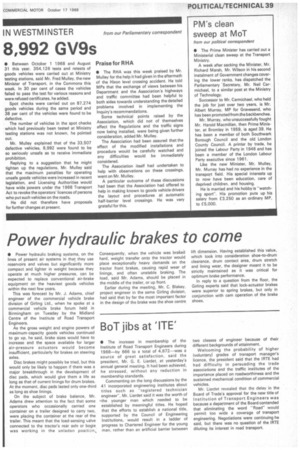Power hydraulic brakes to come
Page 41

If you've noticed an error in this article please click here to report it so we can fix it.
• Power hydraulic braking systems, on the lines of present air systems in that they use reservoirs and valves but significantly more compact and lighter in weight because they operate at much higher pressures, can be expected to replace conventional air-brake equipment on the heaviest goods vehicles within the next few years.
This was forecast by Mr. J. Adams, chief engineer of the commercial vehicle brake division of Girling Ltd., when he spoke at a commercial vehicle brake forum held in Birmingham on Tuesday by the Midland Centre of the Institute of Road Transport Engineers.
As the gross weight and engine powers of maximum-capacity goods vehicles continued to go up, he said, brake sizes would have to increase and the space available for larger air-pressure actuators would become insufficient, particularly for brakes on steering axles.
Disc brakes might possibly be tried, but this would only be likely to happen if there was a major breakthrough in the development of disc pads, which would give them a life as long as that of current linings for drum brakes. At the moment, disc pads lasted only one-third as long as shoe linings.
On the subject of brake balance, Mr. Adams drew attention to the fact that some operators who occasionally carried one container on a trailer designed to carry two, were placing the container at the rear of the trailer. This meant that the load-sensing valve connected to the tractor's rear axle or bogie was working in the unladen positicin. Consequently, when the vehicle was braked hard, weight transfer onto the tractor would place exceptionally heavy demands on the tractor front brakes, causing rapid wear of linings, and often unstable braking. The load, said Mr. Adams, should be placed in the middle of the trailer, or up front.
Earlier during the meeting, Mr. C. Blakey, project engineer in the same Girling division, had said that by far the most important factor in the design of the brake was the shoe centre lift dimension. Having established this value, which took into consideration shoe-to-drum clearance, drum contact area, drum stretch and lining wear, the designer meant it to be strictly maintained as it was critical for optimum brake performance.
In reply to a question from the floor, the Girling experts said that lock-actuator brakes were superior to spring brakes, but only in conjunction with cam operation of the brake shoes.




























































































































